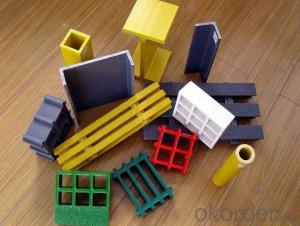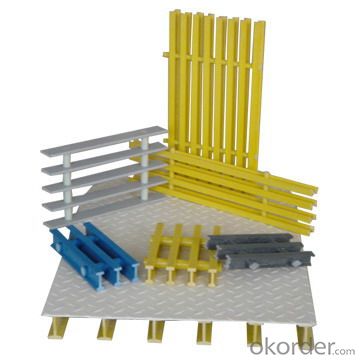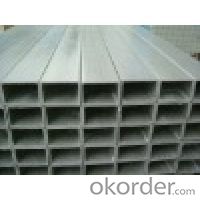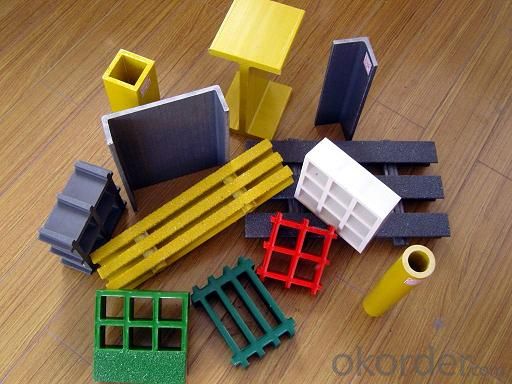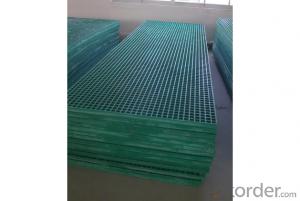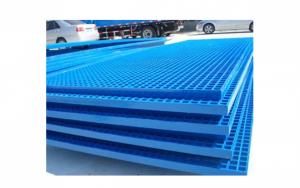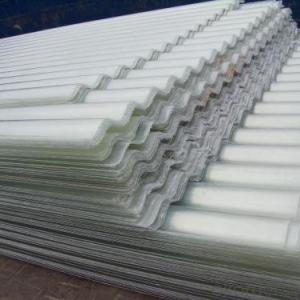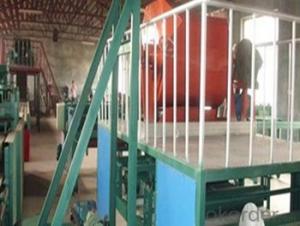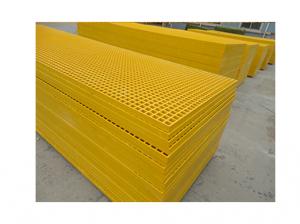FRP Pultrusion Profiles - Pultruded Molded Gratings with High Strength and Corrosion Resistance
- Loading Port:
- Tianjin
- Payment Terms:
- TT OR LC
- Min Order Qty:
- 50 m
- Supply Capability:
- 30000 m/month
OKorder Service Pledge
OKorder Financial Service
You Might Also Like
Specification
PRODUCT DESCRIPTION
Pultruded grating is made by a particular assembly process, which using “I” shape as its main load-bearing and special rod to go through the bearing bar. Pultruded grating include the standard grating and the custom grating, the custom grating can be designed to meet customer’s requirement or special using condition by changing the shape, size and space of the bearing bars, the surface can be covered with lozenge panel, grit panel, or added the anti-slippery sand directly.
FRP pultruded grating has the most characteristics of molded grating, but it has its distinct advantages, it has very high fiberglass content in the loading direction, so it has very high load capability, it has more superiority when used at wide span, so that the basic support will be decreased and the project cost will be reduced accordingly.
FEATURES
a. anti-corrosion, non-rusty
b. lightweight and high strength
c. anti-flammable
d. anti-fatigue
e. anti-slippery and safety
f. anti-ageing
g. easy to installation and maintenance
h. excellent electromagnetism property
DETAILED PARAMETER TABLE
Thickness (mm) | Bar width (mm) | Openspace (mm) | Open rate (%) | Approx weight (kg/m 2 ) |
25.4 | 15.2 | 22.8 | 60 | 13.2 |
25.4 | 15.2 | 15.2 | 50 | 15.9 |
25.4 | 15.2 | 10.1 | 40 | 18.5 |
25.4 | 40 | 10.8 | 21 | 14.5 |
38.1 | 15.2 | 22.8 | 60 | 15.8 |
38.1 | 15.2 | 15.2 | 50 | 19.1 |
38.1 | 15.2 | 10.1 | 40 | 22.4 |
50.8 | 25.4 | 25.4 | 50 | 16.6 |
50.8 | 25.4 | 12.7 | 33 | 21.1 |
PICTURES
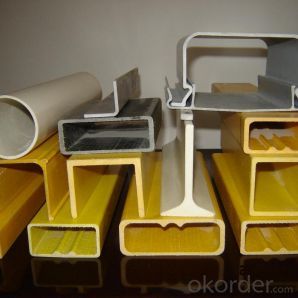
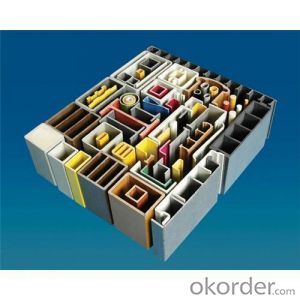

- Q: How do FRP pultrusion profiles handle cyclic loading?
- FRP pultrusion profiles are renowned for their exceptional performance in the face of cyclic loading. The pultrusion process combines unique materials and manufacturing techniques to create profiles that are highly resistant to fatigue and the effects of cyclic loading. One key factor that contributes to the outstanding performance of FRP pultrusion profiles under cyclic loading is their inherent high strength-to-weight ratio. These profiles are created using continuous fibers, typically fiberglass, that are saturated with a resin matrix. This results in a lightweight yet sturdy material that can endure repeated loading without significant degradation or fatigue. Furthermore, the pultrusion process allows for precise control over the fiber orientation and resin distribution within the profile. This ensures a consistent and uniform composition throughout the entire length of the profile. Consequently, FRP pultrusion profiles exhibit excellent load distribution characteristics, reducing stress concentrations and preventing localized failure under cyclic loading conditions. In addition, the corrosion resistance of FRP pultrusion profiles is pivotal in their ability to withstand cyclic loading. Unlike conventional materials like steel, FRP profiles are not susceptible to corrosion-related issues such as rust or pitting. This corrosion resistance guarantees that the profiles retain their structural integrity even when subjected to cyclic loading over extended periods. In summary, FRP pultrusion profiles are purposefully designed and manufactured to withstand cyclic loading conditions. Their high strength-to-weight ratio, uniform material composition, and corrosion resistance make them ideal for applications where cyclic loading is a significant concern. Whether it is in the realm of structural reinforcements, bridges, sporting equipment, or various industrial applications, FRP pultrusion profiles have consistently proven to be reliable and durable under cyclic loading.
- Q: Are FRP pultrusion profiles resistant to electrical arcing?
- Generally, FRP pultrusion profiles exhibit resistance to electrical arcing due to their composition of non-conductive materials such as fiberglass reinforced plastic. By not conducting electricity, these profiles prove to be an optimal choice when concerns arise regarding electrical arcing and conductivity. Nevertheless, it is crucial to acknowledge that the extent of their resistance to electrical arcing may differ based on the unique composition and design of the FRP pultrusion profiles. Therefore, it is advisable to consult the manufacturer or supplier of the profiles to ensure they meet the specific electrical resistance standards required for a given application.
- Q: How do FRP pultrusion profiles perform in heavy-load applications?
- The exceptional performance of FRP pultrusion profiles in heavy-load applications is well-known. These profiles can withstand substantial loads without compromising structural integrity, thanks to their high strength-to-weight ratio. The pultrusion process ensures that the fibers are uniformly distributed and aligned along the length of the profile, resulting in superior strength and stiffness. In heavy-load applications, FRP pultrusion profiles demonstrate excellent load-bearing capabilities. They possess a high modulus of elasticity, enabling them to resist deformation under heavy loads and ensuring long-term durability. Moreover, these profiles have a high ultimate tensile strength, allowing them to withstand extreme forces without breaking or deforming. Additionally, FRP pultrusion profiles exhibit corrosion resistance, making them ideal for use in harsh environments. Unlike traditional materials such as steel, FRP does not rust or corrode, ensuring a longer lifespan and reduced maintenance costs. Another advantage of FRP pultrusion profiles in heavy-load applications is their electrical insulation properties. They do not conduct electricity, making them suitable for environments where electrical conductivity is a concern. Furthermore, compared to traditional materials like steel or concrete, FRP pultrusion profiles are lightweight. This characteristic simplifies transportation and installation, while also reducing overall project costs. In conclusion, FRP pultrusion profiles excel in heavy-load applications. Their high strength-to-weight ratio, excellent load-bearing capabilities, corrosion resistance, electrical insulation properties, and lightweight nature make them the preferred choice for various industries, including construction, infrastructure, marine, and transportation.
- Q: Can FRP pultrusion profiles be used in electrical or telecommunications applications?
- Yes, FRP (Fiber Reinforced Polymer) pultrusion profiles can be used in electrical or telecommunications applications. FRP pultrusion profiles are known for their excellent electrical insulating properties, high strength-to-weight ratio, and corrosion resistance. These characteristics make them suitable for various electrical and telecommunications applications. In electrical applications, FRP pultrusion profiles can be used as electrical insulators, cable trays, busbar supports, and electrical enclosures. They provide insulation and protection against electrical shocks and are often chosen as an alternative to traditional materials like metal or wood due to their non-conductive properties. Additionally, FRP pultrusion profiles are lightweight and easy to install, which further adds to their suitability in electrical applications. In telecommunications applications, FRP pultrusion profiles are used for cable management systems, antenna supports, and equipment enclosures. Similar to electrical applications, the non-conductive nature of FRP pultrusion profiles ensures the safety and reliability of the telecommunications infrastructure. The profiles can also be customized to meet specific design requirements, such as incorporating cable routing channels or mounting brackets for equipment. Furthermore, FRP pultrusion profiles offer excellent resistance to harsh environmental conditions, such as moisture, UV radiation, and chemicals. This makes them ideal for outdoor electrical or telecommunications installations, where exposure to these elements is common. Overall, FRP pultrusion profiles have proven to be a reliable and cost-effective choice for electrical and telecommunications applications, providing insulation, strength, durability, and resistance to environmental factors.
- Q: Can FRP pultrusion profiles be used in the production of electrical busbars?
- Yes, FRP pultrusion profiles can be used in the production of electrical busbars. FRP (Fiber Reinforced Plastic) pultrusion profiles offer several advantages such as high strength, excellent electrical insulation properties, and resistance to corrosion, making them suitable for use in electrical applications like busbars. They provide a lightweight and durable alternative to traditional materials like copper or aluminum, and their non-conductive nature ensures safety in electrical systems.
- Q: Are FRP pultrusion profiles resistant to sulfuric acid?
- FRP (Fiber Reinforced Polymer) pultrusion profiles are generally resistant to sulfuric acid. The corrosion resistance of FRP profiles is one of their key advantages compared to traditional materials like steel or concrete. Sulfuric acid is a highly corrosive substance, but FRP pultrusion profiles can withstand its effects due to the inherent properties of the composite materials used in their construction. The corrosion resistance of FRP profiles is mainly attributed to the resin matrix that encapsulates the reinforcing fibers. Most commonly used resins in pultrusion, such as polyester, vinyl ester, or epoxy, have excellent chemical resistance properties, including resistance to sulfuric acid. However, it is important to note that the resistance of FRP pultrusion profiles to sulfuric acid can vary depending on several factors. The concentration and temperature of the acid, as well as the specific resin formulation used in the profile, can influence the overall resistance. In highly concentrated or elevated temperature environments, it is advisable to consult with the manufacturer or supplier to ensure the specific FRP profile meets the required resistance level. In general, FRP pultrusion profiles offer a high level of resistance to sulfuric acid, making them suitable for various applications in industries where this corrosive substance may be present, such as chemical processing, wastewater treatment, or mining.
- Q: Are FRP pultrusion profiles resistant to chemicals used in pulp and paper mills?
- FRP pultrusion profiles have gained recognition due to their exceptional resistance to chemicals, making them a suitable option for a variety of applications, including those in pulp and paper mills. These profiles have been specially engineered to endure exposure to a wide range of chemicals commonly employed in these industries. The chemical resistance of FRP pultrusion profiles can be attributed to the inherent properties of the composite materials utilized in their construction. Typically, these profiles consist of a blend of resins (such as polyester or vinyl ester) and reinforcements (such as fiberglass or carbon fiber). This blend endows the final product with a high level of chemical resistance. The resins employed in FRP pultrusion profiles play a pivotal role in determining their chemical resistance. Polyester resins, for example, offer commendable resistance to various chemicals, including acids, alkalis, and solvents. Conversely, vinyl ester resins provide even greater chemical resistance, making them suitable for highly corrosive environments. Furthermore, the reinforcement materials used in FRP pultrusion profiles, such as fiberglass or carbon fiber, further amplify their chemical resistance. These reinforcements function as a barrier, preventing chemical infiltration and safeguarding the structural integrity of the profile. It is important to note that the specific chemical resistance of FRP pultrusion profiles may vary depending on the chosen resin and reinforcement materials. Therefore, it is imperative to opt for profiles that have been specifically designed and manufactured to withstand the chemicals commonly encountered in pulp and paper mills. In conclusion, FRP pultrusion profiles undeniably exhibit resistance to the chemicals utilized in pulp and paper mills. Their remarkable chemical resistance, coupled with other advantageous properties like high strength-to-weight ratio and corrosion resistance, render them an ideal choice for these demanding industrial environments.
- Q: Can FRP pultrusion profiles be used in the transportation and logistics industry?
- FRP pultrusion profiles have the capability to be utilized in the transportation and logistics sector. They possess a multitude of advantages that render them suitable for diverse applications within this industry. To begin with, FRP pultrusion profiles are both lightweight and exceptionally robust, ensuring durability. This characteristic makes them highly suitable for implementation in transportation vehicles such as trucks, trailers, and containers, where weight reduction is crucial for enhancing fuel efficiency and minimizing emissions. Despite their lightweight nature, FRP pultrusion profiles are capable of enduring heavy loads and harsh environmental conditions, thereby guaranteeing their reliability and longevity. Furthermore, FRP pultrusion profiles exhibit remarkable resistance to corrosion. Unlike conventional materials like steel or aluminum, FRP does not succumb to rust or corrosion when subjected to moisture or chemicals. This renders FRP profiles apt for applications in transportation and logistics that involve exposure to corrosive substances like saltwater, chemicals, or acidic environments. By incorporating FRP pultrusion profiles, companies can curtail maintenance expenses associated with corrosion and prolong the lifespan of their equipment. In addition, FRP pultrusion profiles offer flexible design options. They can be manufactured in a myriad of shapes, sizes, and configurations to cater to the specific requirements of transportation and logistics applications. Whether it entails structural components, platforms, flooring, or supports, FRP profiles can be tailored to accommodate diverse needs, thereby ensuring optimal performance and functionality. Moreover, FRP pultrusion profiles possess exceptional electrical and thermal insulation properties. This renders them suitable for applications in which electrical conductivity needs to be minimized or thermal insulation is necessary. Within the transportation and logistics industry, this feature can be advantageous for applications like insulation for refrigerated containers or electrical insulation for specialized vehicles. In conclusion, FRP pultrusion profiles are highly suitable for implementation in the transportation and logistics sector. Their lightweight, robust, corrosion-resistant, and customizable nature, combined with their electrical and thermal insulation properties, render them a dependable choice for diverse applications within this field.
- Q: Can FRP pultrusion profiles be used in the construction of modular buildings?
- Yes, FRP pultrusion profiles can be used in the construction of modular buildings. FRP (Fiber Reinforced Plastic) pultrusion profiles offer several advantages such as high strength-to-weight ratio, corrosion resistance, and design flexibility. These profiles can be easily fabricated into various shapes and sizes, making them suitable for modular building applications. Additionally, FRP pultrusion profiles are durable, low-maintenance, and exhibit excellent thermal insulation properties, making them a reliable choice for constructing modular buildings.
- Q: What are the mechanical properties of FRP pultrusion profiles?
- FRP (Fiber Reinforced Polymer) pultrusion profiles possess several desirable mechanical properties that make them a popular choice in various industries. Some of the key mechanical properties of FRP pultrusion profiles include: 1. High Strength: FRP pultrusion profiles exhibit exceptional tensile and flexural strength, making them suitable for applications requiring load-bearing capabilities. The reinforcing fibers, such as carbon, glass, or aramid, provide the profiles with superior strength-to-weight ratios compared to traditional materials like steel or aluminum. 2. Lightweight: FRP pultrusion profiles are significantly lighter than metals, resulting in reduced transportation and installation costs. The low weight also makes them easier to handle and manipulate during construction or manufacturing processes. 3. Corrosion Resistance: Unlike metals, FRP pultrusion profiles are inherently corrosion-resistant. They do not rust, corrode, or degrade when exposed to harsh environments, including moisture, chemicals, or UV radiation. This property makes them ideal for applications in marine, chemical, and infrastructure industries. 4. Dimensional Stability: FRP pultrusion profiles offer excellent dimensional stability, meaning they retain their shape and size even under extreme temperature variations. They have minimal thermal expansion and contraction rates, ensuring long-term structural integrity. 5. Electrical Non-Conductivity: FRP profiles are non-conductive and possess excellent electrical insulation properties. This property is crucial in applications where electrical conductivity must be avoided, such as in electrical enclosures or infrastructure near power lines. 6. Design Flexibility: FRP pultrusion profiles can be manufactured in various complex shapes and sizes, allowing for customized designs to meet specific application requirements. They can be easily molded or formed during the manufacturing process, making them adaptable to diverse project needs. 7. Impact Resistance: FRP pultrusion profiles exhibit good impact resistance, absorbing and dispersing energy when subjected to mechanical loads. This property ensures durability and structural integrity, making them suitable for applications prone to impact or dynamic loading, such as construction, transportation, or sporting equipment. Overall, the mechanical properties of FRP pultrusion profiles make them an attractive alternative to traditional materials in a wide range of industries, offering strength, durability, and corrosion resistance while being lightweight and easy to work with.
Send your message to us
FRP Pultrusion Profiles - Pultruded Molded Gratings with High Strength and Corrosion Resistance
- Loading Port:
- Tianjin
- Payment Terms:
- TT OR LC
- Min Order Qty:
- 50 m
- Supply Capability:
- 30000 m/month
OKorder Service Pledge
OKorder Financial Service
Similar products
Hot products
Hot Searches
Related keywords





